:: SHELLS ::
Depending on the year you bought my music, shells may or may not appear in your scores. This FAQ tab is perfect for listing and sharing with all harpists around the globe the shells that have been found in my manuscripts over the years.
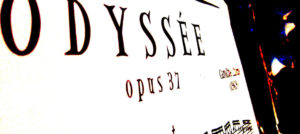
ODYSSÉE opus 37 for solo harp
- page 1 ; 4th system ; 4th bar 2/4 ; 1st beat : in the bass clef, instead of reading an Ab octave written in normal sounds, we should read the low Ab written in esoteric sounds – as a result from the pedal gliss, and the Ab one octave higher should be played and heard on the 1st beat. In the treble clef, we should read a G octave in eight-note instead of an eight-rest
- page 1 ; 5th system ; 1st bar 2/4 ; 1st beat : same as mentionned above in the bass clef only
- page 2 ; 4th system ; 3rd bar ; 2nd beat upper staff : the A should be an eight-note instead of a sixteenth-note. Also, the pedal indication C flat is missing at the end of the first beat for this bar
- page 3 ; 3rd system ; 2nd bar : these three bars of 4/4 must be changed onto two bars of 6/4. The 4/4 comes back at the 4th system’s 1st bar
- page 3 ; 4th system ; 1st bar : G-Bb in the bass clef are both in harmonic sounds (played where written)
- page 3 ; 4th system ; 3rd bar : the Bb of the treble clef is in harmonic sound (played where written)
- page 3 ; 5th system ; last bar in 3/8 : in treble clef, courtesy alterations for the C natural and F natural are missing, as well as for the pedal indications C and F natural at the beginning of the bar
- page 5 ; 1st system; last two bars : senza rall. must be changed to a poco rall. then a tempo on the first bar of the 2nd system
- page 5 ; 2nd system ; 1st bar ; 2nd beat : the A is flat in treble clef
- page 5 ; 4th system ; 2nd bar; bass clef: the last sixteenth note is an A instead of a B
- page 6 ; 1st system ; 3rd bar ; upper staff : a tie is missing on the B natural from the 3rd to the 4th beat
- page 6 ; 2nd system ; 2nd and 3rd bars; upper staves : between the 1st and 2nd beats, the two consecutive B natural are tied
- page 6 ; 5th system : thirty-second notes are corrected by sixty-fourth notes (sixteenth notes remain unchanged), completing a single measure instead of two, before the D octave. Note that B’s are sharp # inside these sixty-fourths
- page 7 ; 1st system; 3rd bar : thirty-second notes are corrected by sixty-fourth notes (sixteenth notes remain unchanged), completing a single measure instead of two, before the B octave
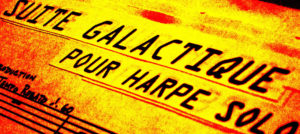
SUITE GALACTIQUE opus 39 for solo harp
- page 1 ; 2nd system ; 1st bar : add a flat in front of the low A left hand
- page 1 ; 4th system ; 2nd bar : take off the slur that ties the Eb’s between the 2nd and 4th beats. We must replay the Eb on the 4th beat
- page 2 ; 4th system ; 2nd bar : a courtesy treble clef is missing at the beginning of this bar
- page 3 ; 4th system : bass clef in front of the 1st low 6th octave A
- page 4 ; 2nd and 4th systems ; the two inserts indicated metric eightnote=120 : we must add the indications loco after these inserts for both staves, so that the following notes are not played one octave higher
- page 4 ; 4th system ; the glissando that begins on the 6th octave E : among the gliss componant notes, we must change the G# for a Gb. No need of pedal change
- page 5 ; 4th system ; end of the 1st bar to the beginning of the 2nd bar : the slur that links the Ab is a phrasé indication for the melody Ab-B-E … it is not a tie to the next bar’s Ab, it Then the arpeggiated chord Ab-E-Ab of the 2nd bar is played entirely
- page 6 ; 1st system ; 1st bar : we must add flats for the A’s octaves written into the 5th and 6th beats in the lower staff
- page 8 ; 2nd system ; 4th bar ; group of sixty-fourth notes : 1st sixty-fourth note is an Ab only
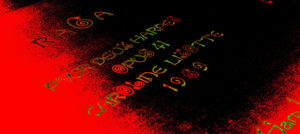
RAGA opus 41 for two harps (score and separate parts)
Harp 1
- bar 29 ; percussion staff (finger cymbal) : we should have a half rest and a quarter rest instead of a dotted half rest and a dotted quarter rest
- senza mesura before letter C : it is permitted to improvise more with the metal sliding key on the A before the down beat of Harp 2 at C
- bars 65 à 68 : gradual crescendo along these four bars
- bars 93-95-97: add the ankle bells simultaneously with the table’s percussive, as they are written at bar 99
- bar 117 : add the G# pedal on the last beat – even if not necessary. Vibrations of the harp will allow to hear the G# in esoteric sounds, which will be more interesting at the listening.
Harp 2
- bar 10 : on the 1st beat, add a courtesy trebel clef a the upper staff
- bar 39 : upper staff ; add a sharp in front of the A
- bar 85 : upper staff ; add a flat in front of the E
- bar 101 : at the bass clef, 2nd beat ; add a 4th octave D in eight-note, as in bar 103
- bar 102 : upper staff ; add a sharp in front of the C
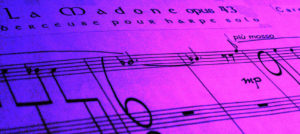
LA MADONE opus 43 lullaby harp solo
- bar 16 : middle staves ; upper staff ; 4th beat ; C with an accent should be double-dotted
- bar 17 : middle staves ; lower staff ; add a treble clef at the beginning of 2/8
- bar 20 : main treble clef ; 1st to 2nd beat ; the two A’s of the octave are tied
- bar 29 : middle staves ; lower staff ; 1st beat ; we should read A#
- bar 30 : main treble clef ; 1st beat : we should read Db
- bar 33 : main treble clef ; the note in parenthesis is a D instead of a B
- bar 38 : main treble clef : F and C are two quarters instead of two half-notes
- bar 54 : middle staves ; upper staff ; 2nd beat : add a courtesy treble clef
- bar 59 : middle staves ; lower staff ; 1st beat : add a courtesy bass clef
- bar 66 : middle staves ; lower staff : add a bass clef in front of the third Ab-C in harmonic sounds
- bar 66 : we shall read molto rall. above the sospiro ; the thirty-second notes in free rhythm must be played from “fast to slow” instead of the contrary, and we may ultimately change the three last 32nds into a triplet that fill the very last sixteen-note of the bar
- bar 67 : 2nd beat : G sharp pedal missing
- bar 68 : 1st beat : A natural pedal missing
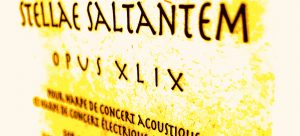
STELLAE SALTANTEM opus 49 for acoustic harp and electric harp
Hp A
- bar 53 : harp part’s upper staff, the A’s are natural for the whole bar
Hp E
- bar 24 : bass clef, the A’s are natural for the two first beats
- bar 50 : the pedals indicated should be B flat-A natural instead of B flat-F natural
- bar 52 : harp part’s upper staff ; 2nd beat, the A is natural
- bar 56 : harp part’s bass clef ; 4th beat, the A is natural
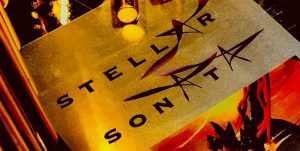
STELLAR SONATA opus 51 for electroacoustic harp
Andare Moderato
- bar 8 : 2nd beat ; upper staff ; B is natural instead of flat
- bar 10 : 1st beat ; lower staff ; B is natural instead of flat
- bar 20 to bar 23 : Tempo 1 on the 2nd beat of bar 20 ; Tempo 2 on the 3rd and 4th beats of bar 20 then on the 1st beat of bar 21 ; Tempo 1 on the 2nd, 3rd and 4th beats of bar 21 as well as for the whole bar 22 ; back to Tempo 2 Energico on bar 23
- bar 28 : 1st beat ; upper staff ; we should read the chord B-D-G-A instead of B-D-A-B
- bar 47 : 1st beat ; left hand chord is arpeggiated while the right hand 5th is non arpeggiated
- bar 58 : 3rd and 4th beats ; lower staff ; all A’s are natural instead of flat
- bar 59 : 3rd and 4th beats ; both upper staff and lower staff ; all F’s are sharp instead of natural
- bar 63 : 2nd beat : we should read the indication Recitativo, which apply until 70 inclusively
- bar 78 : 1st beat : bass clef’s 2nd sixteen-note : G is flat instead of natural
- bar 88 : lower staff : add the flats for all the F’s in the 2nd, 3rd et 4th beats
Ricercare
- bar 27 : 1st beat ; bass clef : the chord is arpeggiated, as played in the next bars
- bar 36 : 1st beat ; treble clef : the chord E-A-E is non-arpeggiated
- bar 43 : indicate “lunga” under the short firmata of the last eight-note for this bar
Radioso Sono
- bar 26 : we should read the dynamic mezzo piano instead of mezzo forte
- bar 38 : cross out the dynamic mezzo forte for this bar
- bar 54 : 2nd beat ; bass clef ; last quarter-note : instead of having an arpeggiated chord C-G-C, we should read non-arpeggiated C-G fifth
- bar 71 : treble clef ; last note of the 1st beat’s sextoplet : we should read F flat
- bar 71 : 3rd beat; treble clef : indicate “bisbigliando” beneath the accelerated group thirty-second-notes
- bar 74 to bar 80 : 2nd beats ; upper staves : the glissandi starting notes are high D’s (6th ledger-line) for all these bars
